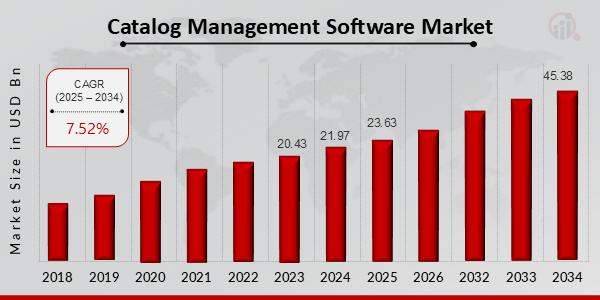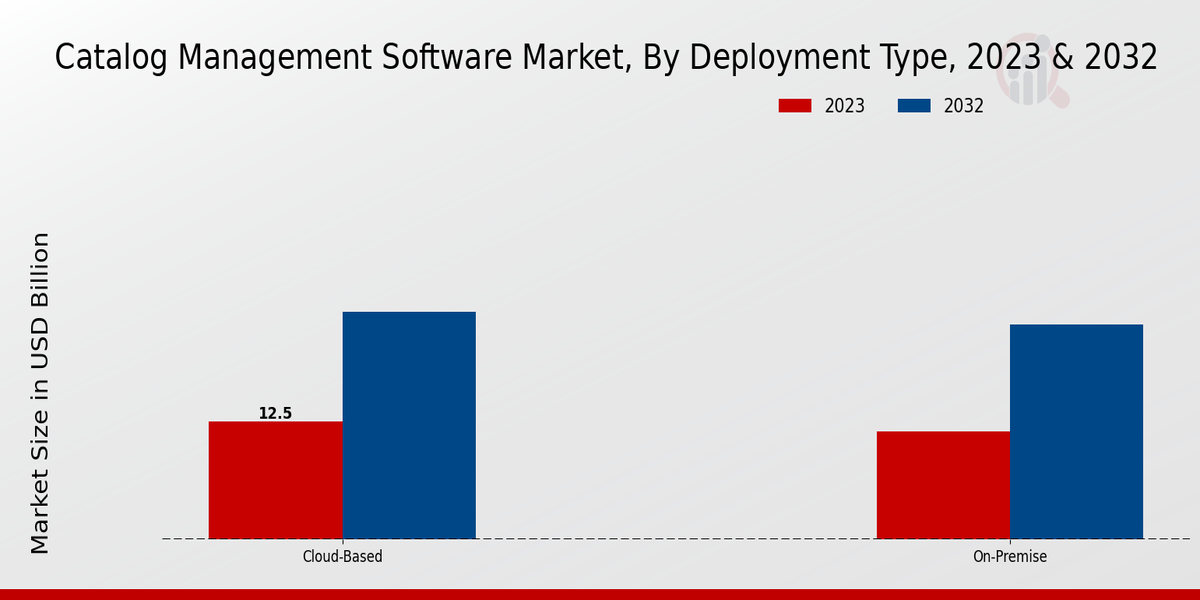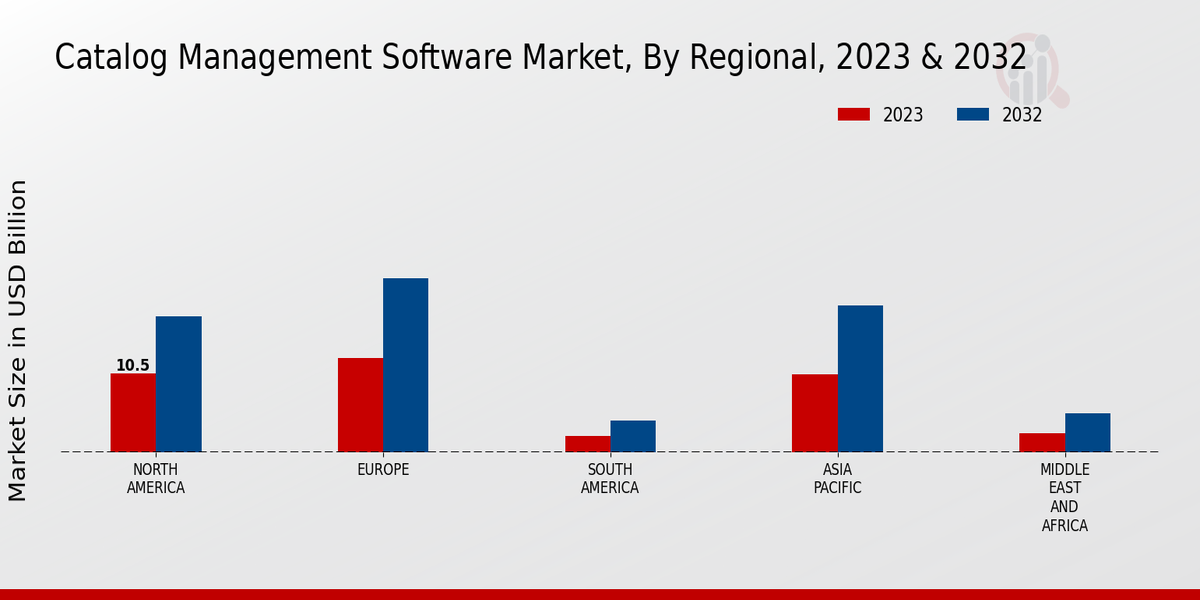Catalog Management Software Market Overview
Catalog Management Software Market is projected to grow from USD 23.63 Billion in 2025 to USD 45.38 Billion by 2034, exhibiting a compound annual growth rate (CAGR) of 7.52% during the forecast period (2025 - 2034).
Additionally, the market size for Catalog Management Software Market was valued at USD 21.97 billion in 2024.
Key Catalog Management Software Market Trends Highlighted
The global catalog management software market is witnessing significant growth due to the increasing adoption of e-commerce and omnichannel retailing. Companies are seeking solutions that enable efficient product data management, optimization, and distribution across multiple channels. The need for real-time product information updates and the ability to handle large volumes of data are driving the demand for advanced catalog management solutions.
Key market drivers include the growing complexity of product catalogs, the need for personalized product recommendations, and the increasing importance of data analytics. Opportunities to be explored include the integration of artificial intelligence (AI) and machine learning (ML) technologies to automate tasks and enhance the customer experience.
Recent trends include the adoption of cloud-based solutions, the rise of headless commerce, and the convergence of catalog management with marketing automation platforms. These trends are creating new opportunities for vendors to offer innovative solutions that meet the evolving needs of businesses and consumers.
Figure 1: Catalog Management Software Market D size 2025-2034

Source: Primary Research, Secondary Research, MRFR Database and Analyst Review
Catalog Management Software Market Drivers
Growing Need for Efficient Product Information Management
In the epoch that prioritized digitalization in all areas of human activity, modern businesses strive to reach a broader target audience by utilizing online channels. Therefore, the requirement for credible and updated information about products or services has been a top priority for both product or service providers and consumers.
The significance of catalog management software in the respective process cannot be overstated, as the latter can be used to store and optimize various data on different products; in other words, catalog management software allows businesses to manage data on all products in one channel, which ensures the content remains consistent across multiple channels and consumer touchpoints.
In addition, the application of respective solutions by businesses enables the automatization of product information management, thus boosting the customer experience by ensuring lower error rates. There can be no doubt that this tendency serves as one of the leading factors defining the current and prospective expansion of the global catalog management software market.
E-commerce and Omnichannel Retailing
The rapidly growing e-commerce industry has contributed to the increasing demand for powerful catalog management solutions. E-commerce businesses need a convenient way to manage and display their product catalogues on the web, showing their products in the best light and giving a detailed description of each item along with photos and specifications.
Catalog management software facilitates the creation of elaborate digital listings that customers can access from anywhere and at any time to place an order. The growing popularity of omnichannel retailing, which implies providing clients with a smooth experience through all available shopping channels, has also increased the demand for centralized catalog management systems.
Regulatory Compliance and Data Security
Stringent regulatory requirements and data protection laws have made it imperative for businesses to effectively manage and protect their product data. Catalog management software offers robust data security features, ensuring compliance with industry regulations and protecting sensitive product information from unauthorized access or breaches. By implementing catalog management systems, businesses can enhance their data security posture, safeguarding customer trust and mitigating potential legal risks.
Catalog Management Software Market Segment Insights
Catalog Management Software Market Deployment Type Insights
The global catalog management software market is segmented by deployment type into cloud-based and on-premise. Cloud-based deployment is expected to hold a significant market share in the coming years due to its numerous advantages, such as scalability, flexibility, and cost-effectiveness.
Cloud-based catalog management software is hosted on a vendor's servers and can be accessed by users over the internet. This eliminates the need for businesses to invest in hardware and software, and it also allows them to scale their operations up or down as needed.
Cloud-based software is typically more affordable than on-premise solutions, and it provides businesses with access to the latest features and updates. On-premise deployment, on the other hand, requires businesses to install and maintain the software on their own servers. This can be a more expensive and complex option, but it also provides businesses with greater control over their data and security. The growth of the market is being driven by the increasing adoption of e-commerce, the need for businesses to manage their product catalogs more efficiently, and the growing popularity of cloud-based software.The competitive landscape of the global catalog management software market is fragmented, with several vendors offering a variety of solutions. Some of the key players in the market include Informatica, SAP, Oracle, IBM, and Adobe. These vendors are constantly innovating and developing new features and capabilities for their software, to meet the changing needs of businesses.
Figure 2 : Catalog Management Software Market 2023-2032

Source: Primary Research, Secondary Research, MRFR Database and Analyst Review
Catalog Management Software Market Organization Size Insights
The global catalog management software market segmentation by organization size includes small and medium-sized enterprises and large enterprises. The SMEs market is expected to take a considerable portion of the market in 2024 because digital innovation has become a driving force for their market strategies and operations as they continue to achieve market growth and better customer experience. The market revenue for SMEs is expected to reach $7.4 billion by 2024, at a CAGR of 8.2%. On the other hand, large enterprises will have a significant share of the market because many of them continue to adopt advanced catalog management solutions to manage their product portfolios as they expand their business markets.
As such, the market size for large enterprises is projected to be $10.3 billion in 2024. Moreover, there is an increased demand for centralized and automated systems that can manage an enterprise’s catalog to ensure accuracy, and easy and fast access of product data.
Catalog Management Software Market Vertical Insights
The global catalog management software market is segmented into various industry verticals, including retail and e-commerce, manufacturing, healthcare, financial services, and education. The Retail and E-commerce segment held the largest market share in 2023, accounting for over 30% of the global catalog management software market revenue. This dominance is attributed to the growing need for efficient product catalog management in the e-commerce sector, where businesses need to manage vast amounts of product data and provide a seamless shopping experience to customers.
The manufacturing segment is also expected to witness significant growth, owing to the increasing adoption of catalog management software to streamline supply chain operations and improve inventory management. Furthermore, the Healthcare segment is projected to expand at a steady pace, driven by the need for effective management of medical catalogs and regulatory compliance.
Catalog Management Software Market Functionality Insights
Product information management (PIM), digital asset management (DAM), order management, inventory management, and customer relationship management (CRM) are the five key functionalities of catalog management software. PIM helps businesses manage and enrich product data, while DAM assists in organizing and storing digital assets.
Order management streamlines the order fulfillment process, and Inventory Management ensures optimal stock levels. CRM integrates customer data to enhance interactions and drive sales. The market growth is attributed to the increasing adoption of e-commerce and the need for efficient catalog management solutions.
Segmentation data indicates that PIM held the largest market share in 2023, followed by DAM and Order Management. Inventory Management and CRM are expected to witness significant growth in the coming years.
Catalog Management Software Market Pricing Model Insights
The pricing model segment of the global catalog management software market offers valuable insights into the various pricing strategies adopted by vendors in the industry. Subscription-based pricing dominates the market, accounting for a significant share of the global catalog management software market revenue in 2023.
This model provides customers with access to the software on a recurring basis, typically through monthly or annual subscriptions. The subscription-based model allows vendors to generate a steady revenue stream and offers customers flexibility in terms of payment and access to the latest features and updates.
Perpetual license pricing, on the other hand, involves a one-time upfront payment for the software, granting the customer perpetual access to the specific version purchased. While this model may have lower upfront costs, it does not include ongoing access to updates and support. The choice between subscription-based and perpetual license pricing depends on factors such as customer preferences, software usage patterns, and the vendor's pricing strategy.
Catalog Management Software Market Regional Insights
The regional segmentation of the global catalog management software market showcases distinct market dynamics across various regions. North America dominates the market, accounting for a significant share of the global catalog management software market revenue. The presence of established vendors, advanced infrastructure, and high adoption rates of digital technologies contribute to its leading position.
Europe follows closely, driven by a growing number of e-commerce businesses and government initiatives promoting digital transformation. The Asia-Pacific region exhibits strong growth potential due to the increasing adoption of cloud-based solutions and the expansion of the e-commerce sector.
South America and the Middle East and Africa (MEA) regions offer emerging opportunities, with growing investments in digital infrastructure and a rising demand for catalog management solutions. These regional insights provide valuable data for businesses looking to expand their presence or target specific markets within the global catalog management software market.
Figure 3 : Catalog Management Software Market 2023-2032

Source: Primary Research, Secondary Research, MRFR Database and Analyst Review
Catalog Management Software Market Key Players and Competitive Insights
Key players in the market are consistently trying to get a competitive edge over their competitors by launching new products and diversifying their product portfolios. Leading players in the catalog management software market are investing considerable sums of money in R to stay ahead of the pack and cater to the changing needs of customers. The catalog management software market is highly competitive; with several well-known vendors vying for customer’s wallet share. Among the key participants in the market are SAP, Oracle, IBM, Adobe, and OpenText to name a few.
They offer catalog management solutions in different forms, from on-premises to cloud-based solutions, and from entry-level to enterprise grade. The competitive landscape is projected to never quite consolidate in the coming years, as new players enter the market, and existing ones diversify their offerings.
SAP is one such player in the market. SAP’s solution empowers businesses to manage their product catalog efficiently. The company offers a full suite of catalog management solutions. Some of the key capabilities of SAP’s offering are, product data management, product data quality, category management, product content management, product import and publication, vendor cross-reference, catalogs for eCommerce, and sales to clients. Users of this solution include manufacturers, retailers, wholesalers, and service providers. One of the major competitors of SAP in the market is Oracle. Oracle offers similar types of solutions to businesses. The company’s solutions are like SAP’s; provide a similar list of capabilities and are used by manufacturers, retailers, and distributors.
Key Companies in the Catalog Management Software Market Include
-
Objectif Lune
-
Agiloft
-
CoreMedia
-
Oracle
-
OpenText
-
Pimcore
-
Stibo Systems
-
IBM
-
Amplifi Commerce
-
inRiver
-
Akeneo
-
Perfion
-
SAP
-
Contentserv
-
Informatica
-
Salsify
Catalog Management Software Market Developments
The Catalog Management Software market is experiencing steady growth, driven by factors such as the increasing adoption of e-commerce and the need for efficient product information management. In 2023, the market was valued at approximately USD 19.0 billion, and it is projected to reach USD 36.5 billion by 2032, exhibiting a CAGR of 7.52%.
Recent market developments include the acquisition of Akeneo by Vista Equity Partners, the launch of new products such as Informatica's Product 360, and the growing popularity of headless commerce solutions. Key players in the market include SAP, Oracle, IBM, and Adobe.
The Asia-Pacific region is expected to witness the fastest growth in the coming years due to the increasing adoption of e-commerce in emerging economies such as India and China. The market is also witnessing the emergence of new trends such as the use of artificial intelligence and machine learning for product information management.
Catalog Management Software Market Segmentation Insights
-
Catalog Management Software Market Deployment Type Outlook
-
Catalog Management Software Market Organization Size Outlook
-
Catalog Management Software Market Vertical Outlook
-
Retail and E-commerce
-
Manufacturing
-
Healthcare
-
Financial Services
-
Education
-
Catalog Management Software Market Functionality Outlook
-
Product Information Management (PIM)
-
Digital Asset Management (DAM)
-
Order Management
-
Inventory Management
-
Customer Relationship Management (CRM)
-
Catalog Management Software Market Pricing Model Outlook
-
Subscription-Based
-
Perpetual License
-
Catalog Management Software Market Regional Outlook
-
North America
-
Europe
-
South America
-
Asia Pacific
-
Middle East and Africa
|
Report Attribute/Metric
|
Details
|
|
Market Size 2024
|
21.97 (USD Billion)
|
|
Market Size 2025
|
23.63 (USD Billion)
|
|
Market Size 2034
|
45.38 (USD Billion)
|
|
Compound Annual Growth Rate (CAGR)
|
7.52% (2025 - 2034)
|
|
Report Coverage
|
Revenue Forecast, Competitive Landscape, Growth Factors, and Trends
|
|
Base Year
|
2024
|
|
Market Forecast Period
|
2025 - 2034
|
|
Historical Data
|
2019 - 2023
|
|
Market Forecast Units
|
USD Billion
|
| Key Companies Profiled |
Objectif Lune, Agiloft, CoreMedia, Oracle, OpenText, Pimcore, Stibo Systems, IBM, Amplifi Commerce, inRiver, Akeneo, Perfion, SAP, Contentserv, Informatica, Salsify |
| Segments Covered |
Deployment Type, Organization Size, Industry Vertical, Functionality, Pricing Model, Region |
| Key Market Opportunities |
Artificial Intelligence Ai-Powered Search Cloud-Based Deployment Personalized Shopping Experiences Integration With E-commerce Platforms Analytics for Catalog Optimization |
| Key Market Dynamics |
E-commerce Expansion Digital Transformation Initiatives Personalization Cloud-based Deployment Growing Adoption in Retail and Manufacturing |
| Countries Covered |
North America, Europe, APAC, South America, MEA |
Frequently Asked Questions (FAQ) :
The global catalog management software market is anticipated to reach USD 19.0 billion in 2023.
The global catalog management software market is projected to grow at a CAGR of 7.52% from 2025 to 2034.
The global catalog management software market is expected to reach USD 45.38 billion by 2034
North America is expected to hold the largest market share in the global catalog management software market.
The retail industry is expected to drive the demand for catalog management software.
Key competitors in the catalog management software market include SAP, Oracle, IBM, Adobe, and OpenText.
Key trends in the market include the increasing adoption of cloud-based solutions and the growing demand for data analytics.
Some challenges posed to the market include the high cost of implementation and the lack of skilled professionals.
Key growth opportunities in the catalog management software market include the increasing demand for e-commerce and the growing adoption of mobile devices.
Some of the key factors driving the growth of the Global Catalog Management Software Market include the increasing need for data management and the growing adoption of digital marketing.

















